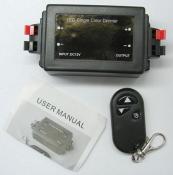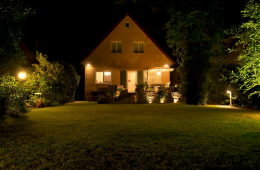Search
Login
Photocell for illumination of a personal plot. How to choose and apply
The coverage of the household territory should be organized in such a way that the rest on the site is comfortable and the energy consumption is rational. To solve this problem, many homeowners install sensors with built-in photocells near the house, by the pool, along garden paths and gazebos.
The photocell regulates the light intensity of street lamps and lamps, which provides convenient lighting control and efficient use of electricity.
Content
- Photocell for street lighting: device and principle of operation video
- The advantages of using solar cells in a personal plot
- Types of photosensors and features of their application
- Tips for choosing photocells to illuminate the site video
- DIY photocell installation for street lighting
Photocell for street lighting: device and principle of operation
Photocell This is a device that converts solar or light energy into electrical energy. The conversion of sunlight is due to the semiconductor materials from which the solar cells are made. Usually it is: amorphous silicon, telluride / cadmium sulfide, thin-film crystalline silicon.
At first, the photocell was used only for conducting scientific experiments, today, engineers improved the photocell and found practical application for it.

A tube amplifier and an electric current control relay were connected to the photocell. Such a device was called a photosensor, and began to be actively used in ubiquitous life and in industries.
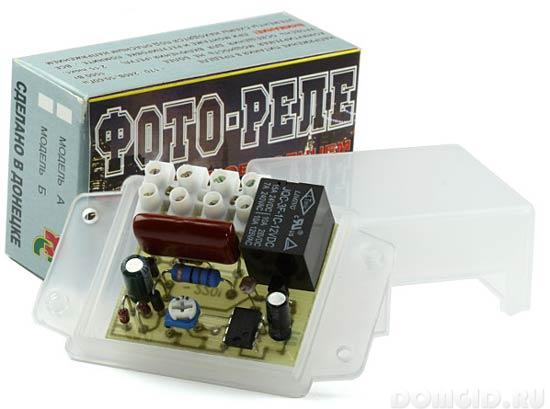
The principle of operation of the photo sensor (photo relay) of street lighting is as follows:
- Solar rays fall on the cathode of the solar cell.
- A solar cell converts the energy of the sun into electricity.
- Electricity passing through a tube amplifier drives a relay.
- The relay operates and reacts by turning on / off the light of electrical appliances connected to it.
Externally, a modern photocell resembles an ordinary light bulb. The photosensor case can be transparent or translucent with a built-in window.
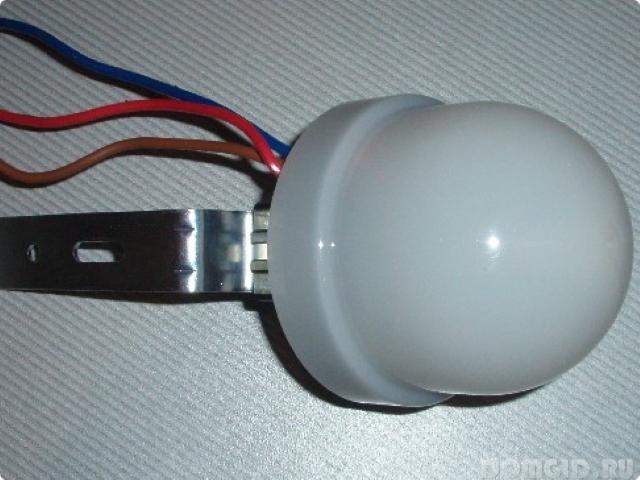
Sensors are tuned to a specific wave of infrared or ultraviolet radiation. Most models are equipped with an additional device that protects the photosensor from unnecessary reactions to interference (light from the headlights of the car).
The sensitivity range can be adjusted depending on the location of the photosensor. That is, poolside lighting can automatically turn on, as soon as the sun's rays hide behind the horizon, and the lights along the paths at dusk.
The advantages of using solar cells in a personal plot
The use of solar cells for street lighting has a number of significant advantages:
- Convenient lighting control in the local area.
- The ability to control the lighting intensity of different areas of the site.
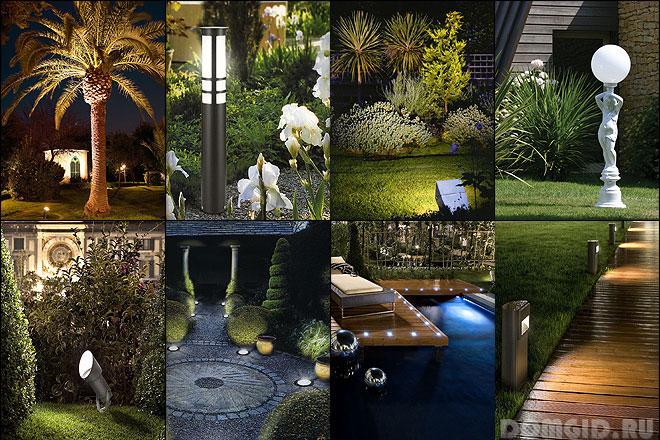
- Significant cost savings for electricity bills. Especially relevant when installing photocells with motion sensors.
- Long life of photocells.
- The photosensors are compact and fit well into the exterior of a country house and the landscape of the garden.
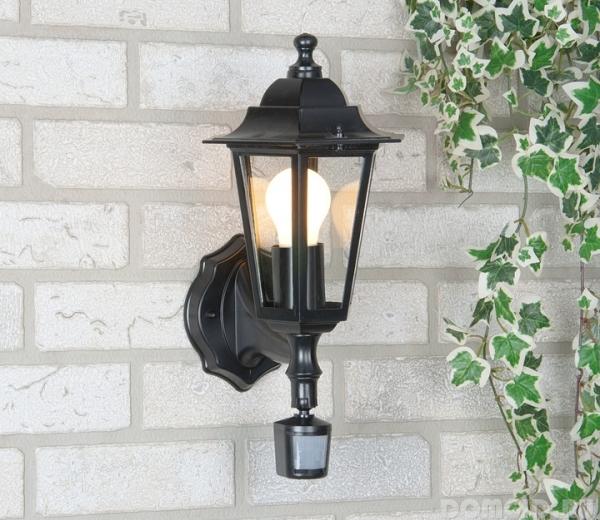
- Ease of installation of photosensors. You can carry out the installation yourself, clearly following the instructions.
- Reasonable price of the photosensor.
Types of photosensors and features of their application
The types of photosensors for street lighting can be divided into several groups:
- Photo sensors with photocell inside the housing. They work in automatic mode: at dusk, the light turns on, and turns off when the sun rises. The protective housing of the photosensor is transparent.
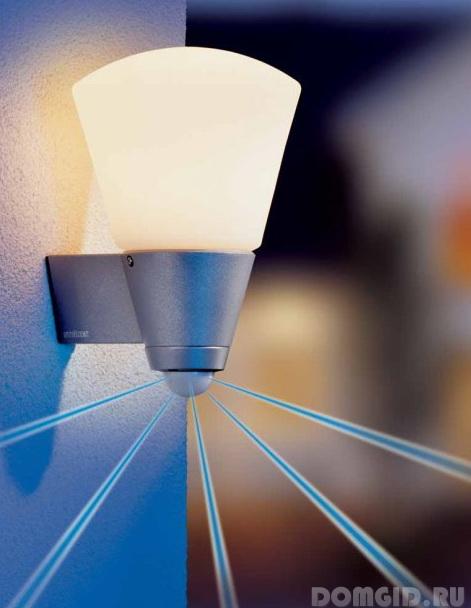
- Photosensors with photocell and timer.It is possible to adjust the lighting intensity depending on the time of day. The operation of the device can be programmed for a specific period: week, month, year. At the cottage it is convenient to use sensors programmed for individual days of the week, for example, to cancel lighting on weekdays, and to activate the operation of lamps and lamps on weekends.
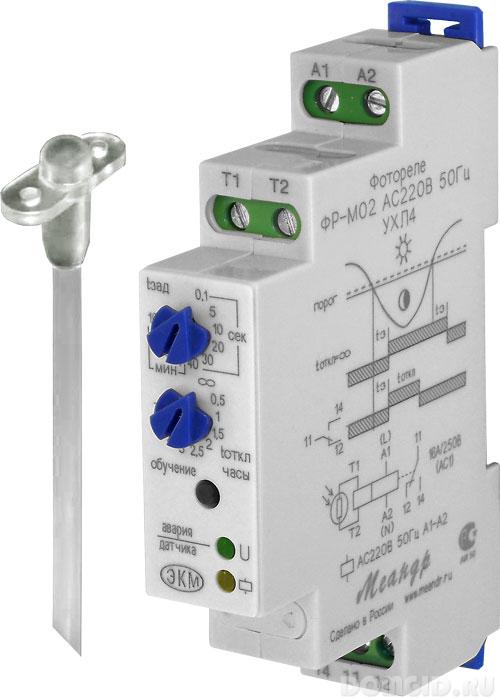
- Adjustable threshold photosensor. The sensor is equipped with a handle, with which you can adjust the allowable threshold of the mechanism. The operation of such a solar cell will not depend on the climatic and weather conditions of the region, as well as on the time of year.
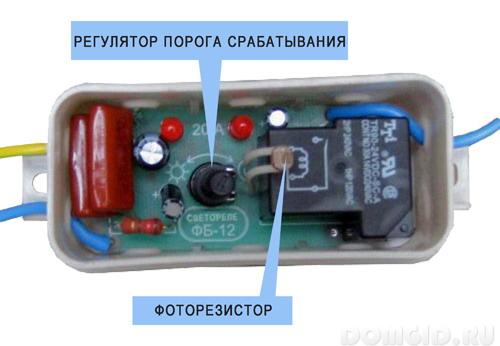
- Photocell with remote photocell. You can install the photocell at a distance of no more than 150 meters from the sensor housing. The unit is in a safe place (mounted in an electrical panel).
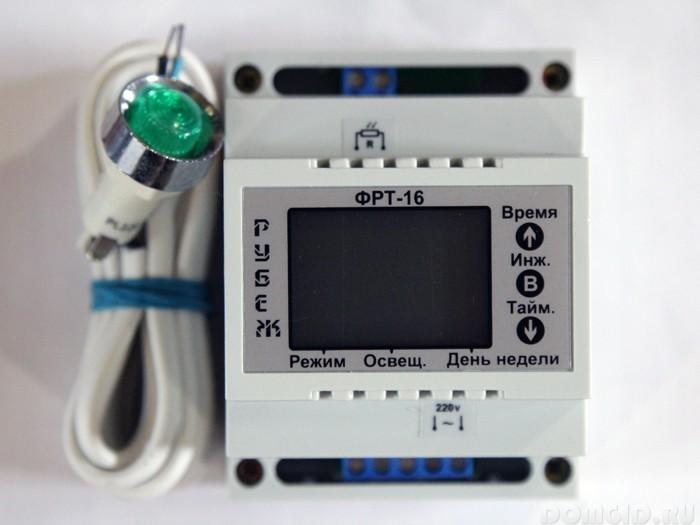
- Photocells with integrated motion sensor. Lighting turns on when the sensor detects any movements in the area.
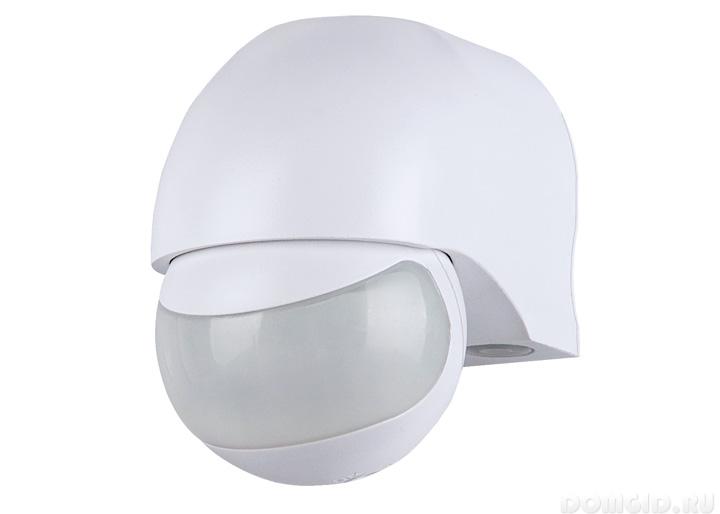
Photocells for lighting with a built-in timer are the most expensive, but their operating mode allows you to achieve significant savings on payment of light bills
Tips for choosing photocells to illuminate the site
The market offers a wide range of solar cells with different technical characteristics, different capabilities and from different manufacturers. When choosing a photosensor, it is necessary to be guided by the main quality criteria:
- High demands are placed on the body of the photosensor. It must be tight and strong.
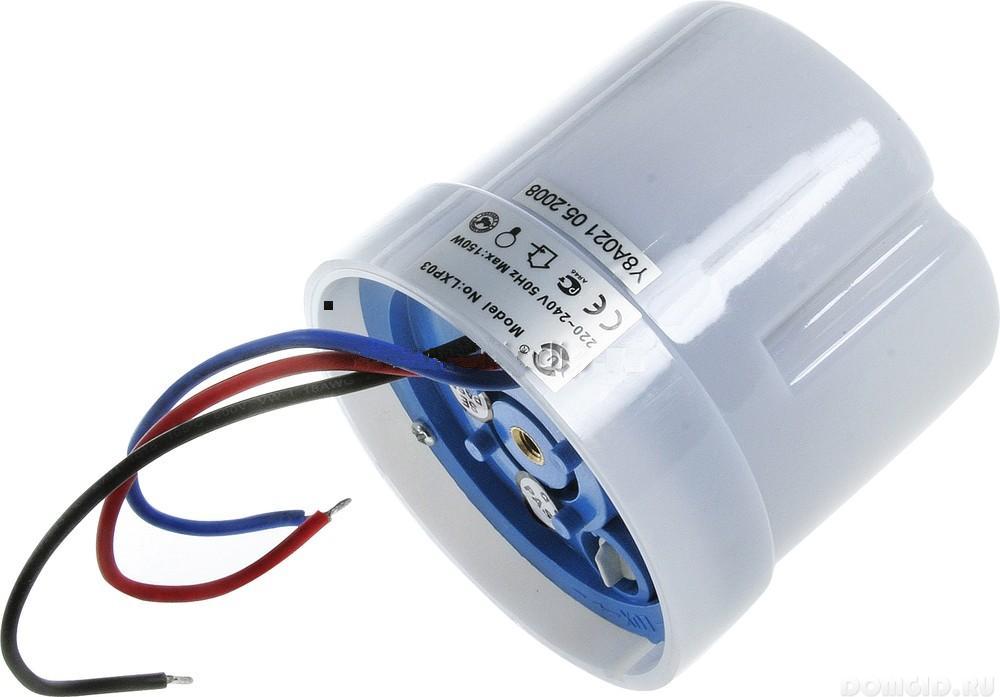
- Response period. Many models respond to changes in light within 5-30 seconds.
- Operating temperature range. The choice depends on the climatic conditions of the region, most sensors have a range from 25C to + 50C.
- The photosensor must have false protection and a potentiometer.
- The photocell must be selected taking into account the power consumed by the lamp. There are ready-made kits on sale in which the photocell is already matched to a suitable electric bulb.
- A device with an external photocell is more difficult during installation; this must be taken into account when planning to install a photo sensor on your own.
- It is necessary to take into account the average annual humidity in the region where the photocell is placed. If necessary, buy a photo sensor with increased protection from adverse weather conditions.
DIY photocell installation for street lighting
rules for placing photo relay
When installing a photocell, be sure to consider the following:
- The photorelay is forbidden to be installed near combustible and flammable materials, near a chemically active medium.
- The device is installed base down.
- Supply voltage must be 220 V, tolerance 10%.
- The light from the switched on lamp or lamp should not fall on the photocell.
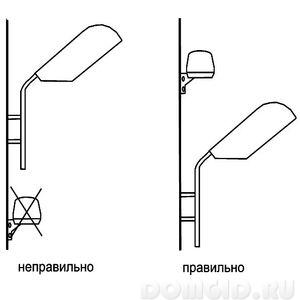
- The working surface of the device should not be in the shade of trees, otherwise the photosensor will not work correctly.
- When connecting the photosensor, it is necessary to follow the diagram indicated on the box from the device.
photosensor connection sequence
Before installation, it is necessary to check that the power of lighting devices does not exceed the power of the photo relay. Better to buy a photo sensor with a 20% power margin
The installation and connection procedure is as follows:
- Mount the bracket to place the photocell on the wall of the house.
- Attach a canopy to the photo relay and install it on the bracket.

- Three wires come out of the photo relay:
- brown phase cable;
- blue zero;
- red extension wire leading to the lamp.
- Connect the wires in the junction box. How to connect a photocell is indicated on the diagram. For connection, triple terminal blocks can be used.
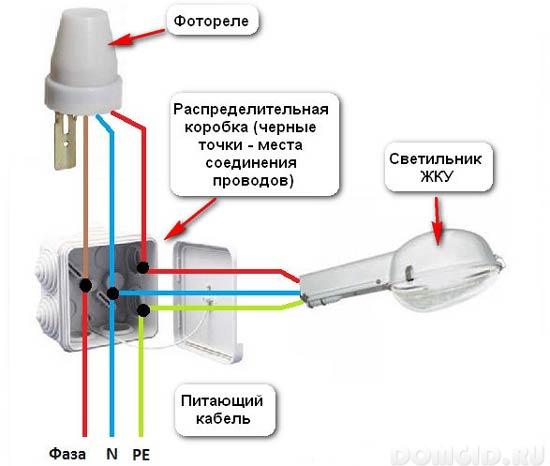
- It is desirable to install a separate machine for this controller in the switchboard.
- To check the correct connection, you need to connect the starter to the network, and see if the flashlight or spotlight will work.
photosensor applications
When arranging street lighting, the photo sensor can be used in two ways:
- Install a photocell for each lamp. This option must be applied if for each lamp personal power is provided, for example, a solar battery. In this case, it will be more difficult to achieve synchronous on / off lights. Some may be in the shade of trees, others in bright light. Constantly it is necessary to control the purity of the optics of each sensor when dusting, the photo relay will not work.
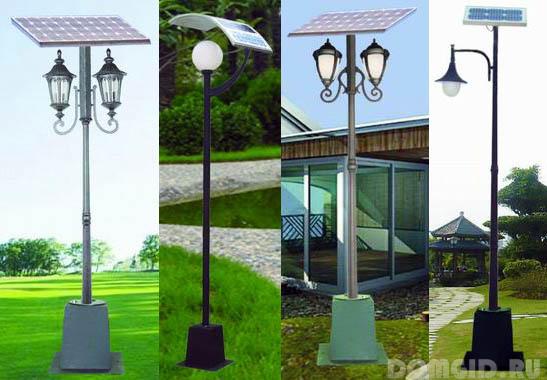
- Installation of one photocell sensor for all lights more convenient option for street lighting. It is used when all the lights located along the track and in the area are connected to a single electrical circuit with a separate switch. The sensor is mounted on the first lamp. The circuit is constantly closed due to the circuit breaker, but due to the high resistance in the phototransistor, current does not flow through it. When dark, the resistance drops, and the circuit completely closes all the lights at the same time light up.
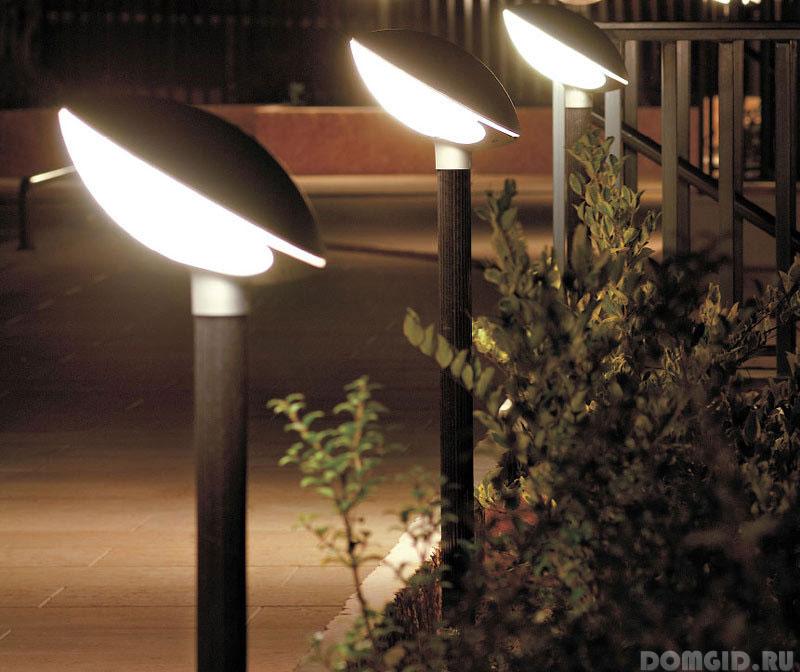
The use of solar cells on a personal plot is a convenient and economical way to organize street lighting. When choosing a photosensor, it is necessary to take into account a number of factors: the location and power of the lamps, the time spent on the site (permanent or seasonal), the presence of additional functions (timer, motion sensor). A correctly selected photocell and its competent installation are the guarantee of a long and uninterrupted operation of the entire lighting system of the local area.


